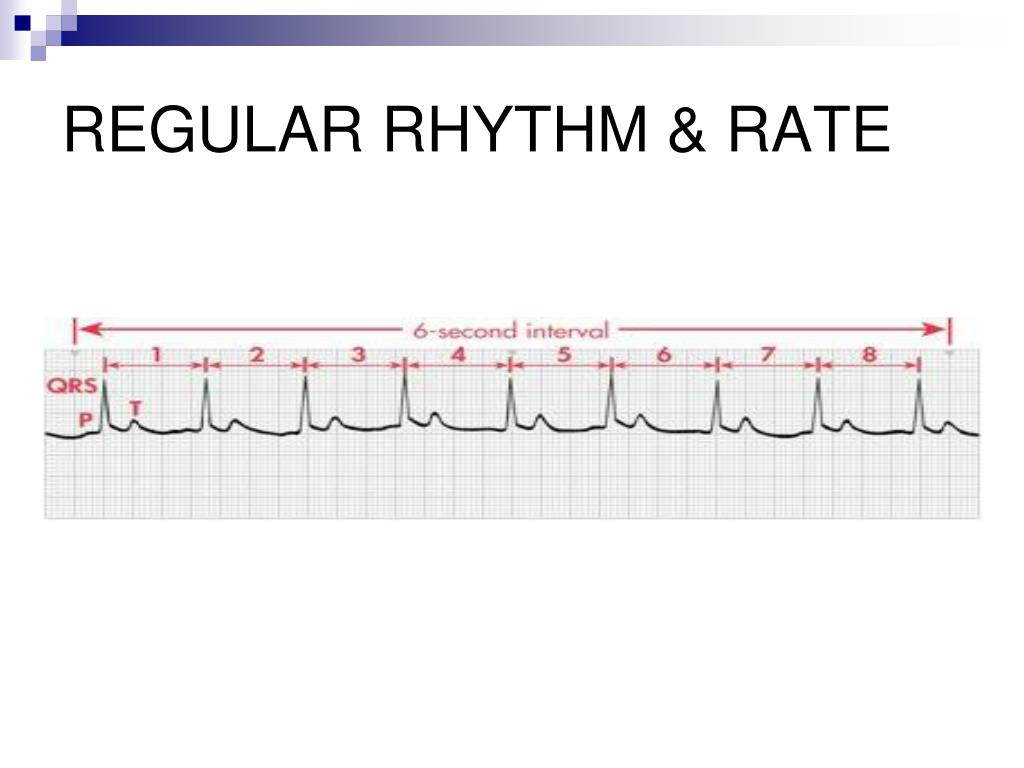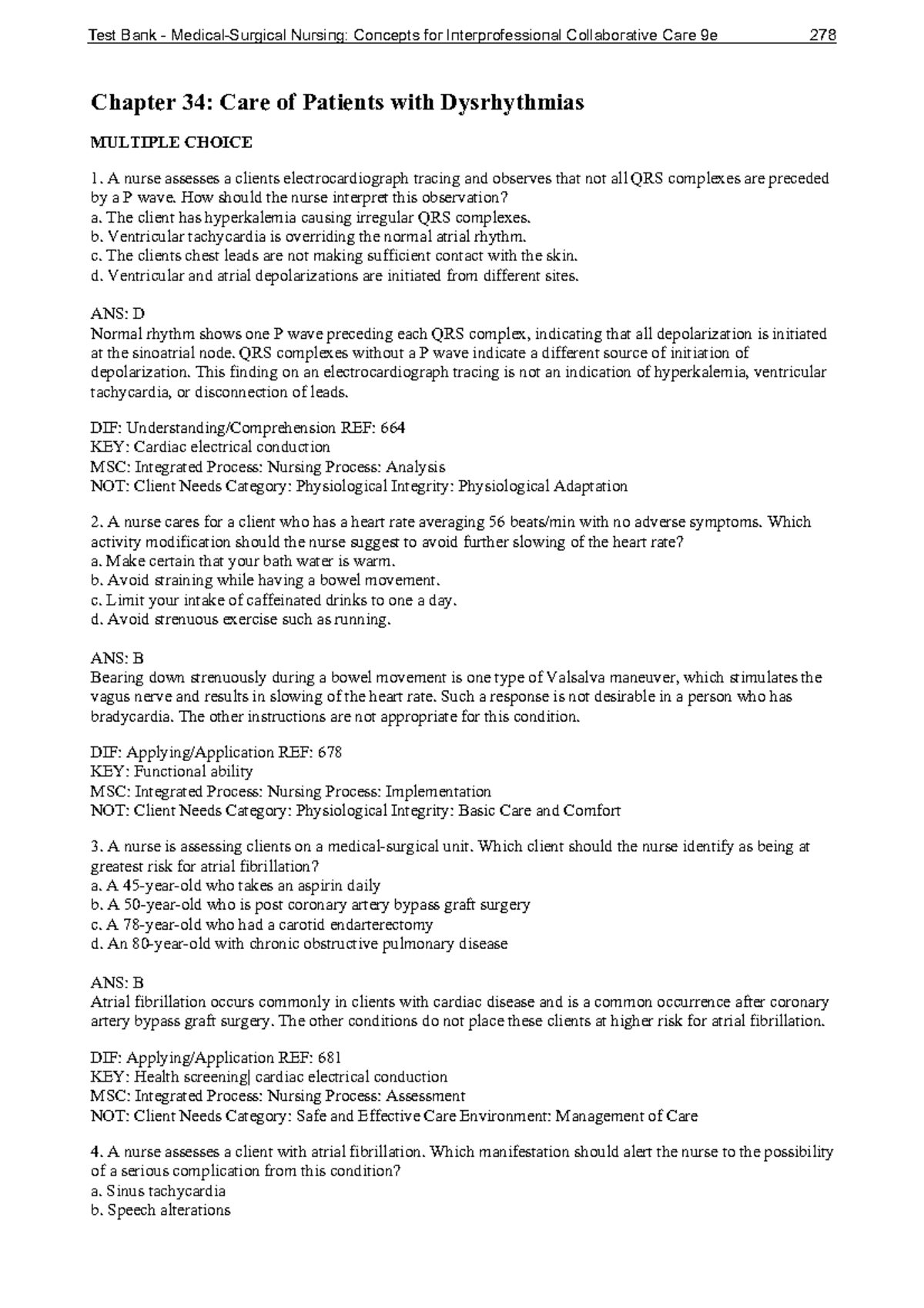Chapter 31 Concepts Of Care For Patients With Dysrhythmias
Chapter 31 Concepts Of Care For Patients With Dysrhythmias - Web start studying chapter 31: The client has hyperkalemia causing irregular qrs complexes. Health promotion and maintenance 2. Concepts of care for patients with dysrhythmias review of cardiac conduction system electrocardiography common dysrhythmias sinus dysrhythmias atrial Concepts the priority concept for this chapter is øperfusion the interrelated concepts for this chapter are øfluid and electrolyte balance øclotting. How would the nurse interpret this observation? Web study with quizlet and memorize flashcards containing terms like a nurse assesses a client's electrocardiograph tracing and observes that not all qrs complexes are preceded by a p wave. The clients chest leads are not making sufficient contact with the skin. Concepts of care for patients with dysrhythmias • the nurse is assessing the client’s cardiac rhythm and notes the following: The client has hyperkalemia causing irregular qrs complexes.
Web patients with afib have an increased risk. Continue to clear the airway. Educate patients and families about procedures and other interventions for common dysrhythmias… Beam, a female patient who was admitted with suspected paroxysmal. Ventricular tachycardia is overriding the normal atrial rhythm. Health promotion and maintenance 2. What is the priority nursing action? Provide a safe environment for patients and staff when using a cardiac defibrillator. Concepts the priority concept for this chapter is øperfusion the interrelated concepts for this chapter are øfluid and electrolyte balance øclotting. Concepts of care for patients with dysrhythmias sa node= heart primary pacemaker themost common dysrhythmia is atrial fibrillation(afib) o high risk of blood clot premature atrial complexeso.
Concepts of care for patients with dysrhythmias. Beam, a female patient who was admitted with suspected paroxysmal. Evidence of embolic events includes. Concepts of care for patients with dysrhythmias. Ventricular tachycardia is overriding the normal atrial rhythm. Learn vocabulary, terms, and more with flashcards, games, and other study tools. Concepts of care for patients with dysrhythmias • the nurse is assessing the client’s cardiac rhythm and notes the following: Web start studying chapter 31: Critical care of patients with acute coronary syndromes section ix: Concepts of care for patients with dysrhythmias.
Chapter 2 Care of Patients With Dysrhythmias Part 2 YouTube
While suctioning a client with a tracheostomy, the client becomes diaphoretic and nauseous, and the heart rate decreases to 37 beats/min. Critical care of patients with shock 35. Concepts of care for patients with dysrhythmias review of cardiac conduction system electrocardiography common dysrhythmias sinus dysrhythmias atrial Concepts of care for patients with dysrhythmias. Concepts of care for patients with dysrhythmias.
Chapter 2 Care of patients with dysrhythmias Part 6 YouTube
Evidence of embolic events includes. Concepts of care for patients with dysrhythmias • the nurse is assessing the client’s cardiac rhythm and notes the following: Concepts of care for patients with dysrhythmias. Concepts of care for patients with dysrhythmias review of cardiac conduction system electrocardiography common dysrhythmias sinus dysrhythmias atrial Concepts the priority concept for this chapter is øperfusion the.
31 yes Chapter 31 Concepts of Care for Patients With Dysrhythmias
The client has hyperkalemia causing irregular qrs complexes. Web patients with afib have an increased risk. Ventricular tachycardia is overriding the normal atrial rhythm. What is the priority nursing action? Concepts of care for patients with dysrhythmias.
PPT Angina & Dysrhythmias PowerPoint Presentation, free download ID
Rapid filling rate that lengthens diastolic filling time and leads to decreased co. The client has hyperkalemia causing irregular qrs complexes. Web patients with afib have an increased risk. Teach patients and their families about drug therapy used for common dysrhythmias. Concepts of care for patients with dysrhythmias review of cardiac conduction system electrocardiography common dysrhythmias sinus dysrhythmias atrial
Chapter 34 Care of Patients with Dysrhythmias Chapter 34 Care of
Concepts of care for patients with dysrhythmias. The client's chest leads are not making sufficient contact with the skin. Beam, a female patient who was admitted with suspected paroxysmal. Inference seen on the monitor or rhythm strip, which may look like a wandering or fuzzy face line; Web patients with afib have an increased risk.
Solved Chapter 34 Care of Patients with Dysrhythmias Case
What is the priority nursing action? Concepts of care for patients with dysrhythmias • the nurse is assessing the client’s cardiac rhythm and notes the following: Ventricular tachycardia is overriding the normal atrial rhythm. Rapid filling rate that lengthens diastolic filling time and leads to decreased co. Evidence of embolic events includes.
Ch31Concepts Care Patients With Dysrhythmias 2/25/ 1 Chapter 31
Care of patients with cardiac problems 33. Care of patients with vascular problems 34. Concepts of care for patients with dysrhythmias. Premature ventricular complexes (pvcs) increased. Web patients with afib have an increased risk.
PPT Angina & Dysrhythmias PowerPoint Presentation, free download ID
The client has hyperkalemia causing irregular qrs complexes. Inference seen on the monitor or rhythm strip, which may look like a wandering or fuzzy face line; While suctioning a client with a tracheostomy, the client becomes diaphoretic and nauseous, and the heart rate decreases to 37 beats/min. Evidence of embolic events includes. Learn vocabulary, terms, and more with flashcards, games,.
Chapter 2 Care of patient with Dysrhythmias Part 4 YouTube
Provide a safe environment for patients and staff when using a cardiac defibrillator. Beam, a female patient who was admitted with suspected paroxysmal. Concepts of care for patients with dysrhythmias review of cardiac conduction system electrocardiography common dysrhythmias sinus dysrhythmias atrial Care of patients with dysrhythmias 32. Concepts of care for patients with dysrhythmias.
Chapter 31 Concepts of Care for Patients with Dysrhythmias
Concepts of care for patients with dysrhythmias. How would the nurse interpret this observation? Concepts of care for patients with dysrhythmias sa node= heart primary pacemaker themost common dysrhythmia is atrial fibrillation(afib) o high risk of blood clot premature atrial complexeso. Beam, a female patient who was admitted with suspected paroxysmal. The clients chest leads are not making sufficient contact.
Beam, A Female Patient Who Was Admitted With Suspected Paroxysmal.
Care of patients with dysrhythmias the nurse is caring for mrs. Care of patients with dysrhythmias the nurse is caring for mrs. Web patients with afib have an increased risk. The client's chest leads are not making sufficient contact with the skin.
How Would The Nurse Interpret This Observation?
Web chapter 31 concepts of care for patients with dysrhythmias aed. Learn vocabulary, terms, and more with flashcards, games, and other study tools. Concepts of care for patients with dysrhythmias. The client has hyperkalemia causing irregular qrs complexes.
Critical Care Of Patients With Acute Coronary Syndromes Section Ix:
Critical care of patients with shock 35. Health promotion and maintenance 2. Learn vocabulary, terms, and more with flashcards, games, and other study tools. Care of patients with dysrhythmias 32.
Rapid Filling Rate That Lengthens Diastolic Filling Time And Leads To Decreased Co.
Concepts of care for patients with dysrhythmias. Beam, a female patient who was admitted with suspected paroxysmal. Changes in mentation, speech, sensory function, and motor function. The clients chest leads are not making sufficient contact with the skin.









